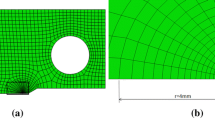Conclusions
-
1.
Nondimensional time at the moment of stress and strain-rate field stabilization is independent of the load applied σo and of the theoretical stress intensity factor, and is determined by the type of stressed condition prevailing.
-
2.
In austenitic-class steels such as 18-8, the accumulated damage is localized mainly at an angle 45–50° to notch plane.
-
3.
At high applied load levels (σo>0.5σT) shear fracture of specimens takes place without the trunk crack penetrating to a considerable depth, but at low levels (σo>0.4σT) it occurs by growth of the trunk crack.
-
4.
The temperature dependence of the\(\dot J_C \)-integral with regard to the moment of crack start is due to the temperature dependence of the creep rate.
-
5.
If the small-scale yield is retained, the crack growth rate can be described by the modified stress intensity factor K *cr .
Similar content being viewed by others
Literature Cited
L. M. Kachanov, Fundamentals of Fracture Mechanics [in Russian], Nauka, Moscow (1974).
V. S. Strelyaev, V. A. Petushkov, and V. G. Krivonogov, “Investigation of creep and long-term strength under a nonuniform stress system,” Probl. Prochn., No. 5, 10–16 (1982).
V. I. Makhnenko, Calculation Methods Used in the Investigation of Kinetics of Welding Stresses and Strains [in Russian], Naukova Dumka, Kiev (1976).
L. J. Segerlind, Applied Finite Element Analysis, Wiley (1976).
J. M. Ortega and W. C. Reinboldt, Iterative Solution of Nonlinear Equations in Several Variables, Academic Press (1970).
R. Otani and S. Taira, “The effect of nonlinear relation between stress and strain rate on strain and fracture of materials in creep,” Teor. Osn. Inzh. Raschetov, No. 4, 71–75 (1979).
R. D. Nicholson and C. L. Formby, “The validity of various fracture mechanics methods at creep temperature,” Int. J. Fracture,11, No. 4, 595–600 (1975).
I. T. Barnby and R. D. Nicholson, “Local stress and strain during crack growth by steadystate creep,” J. Mater. Sci., No. 12, 2099–2108 (1977).
C. Taupa, R. Otani, and T. Kitamura, “Use of\(\dot J\)-integral for crack growth at high temperatures, Part 1,” Teor. Osn. Inzh. Rasch., No. 2, 52–60 (1979).
N. A. Makhutov, “Kinetics of low-cycle fracture development at elevated temperatures,” in: Investigation of Low-Cycle Strength at High Temperatures [in Russian], Nauka, Moscow (1975), pp. 99–120.
D. Broek, Fundamentals of Fracture Mechanics [in Russian], Vysshaya Shkola, Moscow (1980).
V. A. Petrov, “Use of fracture mechanics in the analysis of failure of structural materials at creep temperatures,” Metallovedenie, No. 34, 41–52 (1982).
Yu. N. Rabotnov, Mechanics of Strain of a Solid Body [in Russian], Nauka, Moscow (1979).
Additional information
Leningrad. Translated from Problemy Prochnosti, No. 7, pp. 40–45, July, 1983.
Rights and permissions
About this article
Cite this article
Aminova, I.Y., Petrov, V.A. & Rybin, Y.I. Analytic-experimental determination of kinetic damage and failure at a sharp notch tip in creep conditions. Strength Mater 15, 931–938 (1983). https://doi.org/10.1007/BF01528935
Received:
Issue Date:
DOI: https://doi.org/10.1007/BF01528935




